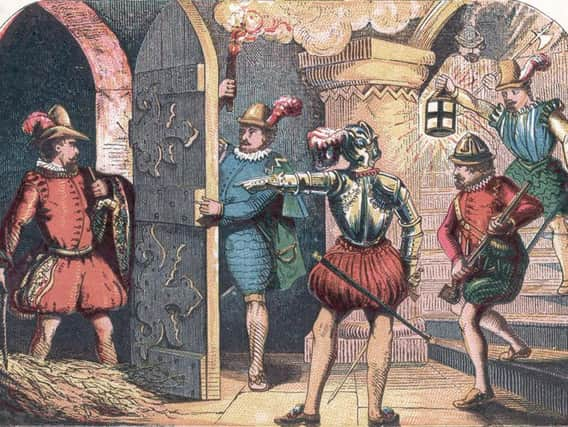A monk's curse may have doomed a Viscount's family


Sometimes when I set off in pursuit of another episode of “County Yarns”, I find myself going in a completely different direction to where I thought I’d be heading. So it is this week when - it getting close to Bonfire Night – I’d thought I’d investigate if there were any Sussex ties to the Gunpowder Plot conspirators.
I began with Guy Fawkes. He was born in Yorkshire in 1570 into a well-off Protestant family. After leaving school Fawkes entered the service of Anthony Browne, 1st Viscount Montagu, as a footman on his estate at Cowdray in West Sussex. How he fetched up there I don’t know but it seems the Viscount was displeased by the young Fawkes and soon dismissed him.
Advertisement
Hide AdAdvertisement
Hide AdFawkes must have maintained contact with the family for he was subsequently employed by Anthony-Maria Browne, who went on to become the 2nd Viscount of Montagu in 1592.
In 1591 the now Catholic Fawkes went to the Netherlands to fight as a soldier for Spain against the Dutch who sought independence from Spanish rule. Apart from his association with Cowdray I could find no further connection between Guy Fawkes and Sussex other than the fact his effigy is burnt every 5th November all over the county and most famously in Lewes. Intriguingly, the 2nd Viscount Montagu was subject to arrest and incarceration in the Tower of London following the Gunpowder Plot in 1605. He most likely came under suspicion because of his earlier association with Fawkes but with no evidence forthcoming he was soon released.
So my search for Sussex links to Guy Fawkes and his fellow conspirators led to a dead end. But in the meantime I had become very interested in the Montagu family history.
Anthony Browne - destined to become the 1st Viscount Montagu - was born in 1528 as the first of six sons of Sir Anthony Browne (there’s that same name again!). Anthony’s mother was Alice Gage, daughter of Sir John Gage of Firle Place, near Lewes. Sir Anthony had been a pal of King Hal (Henry VIII) and during the Reformation was given Battle Abbey from which he promptly turned out the monks. The story goes that the last of the monks to leave cursed Sir Anthony and predicted that his line would surely perish by “fire and water”.
Advertisement
Hide AdAdvertisement
Hide AdThe young Browne was elected MP for Guildford in 1545. He was appointed as an equerry in the royal stables and made a Knight of the Realm at the coronation of Edward VI in 1547.
Browne's open support for Henry VIII's daughter, Mary, antagonized Edward’s courtiers, but he was nevertheless re-elected as Guildford MP and was Sheriff of Sussex in 1552.
After Queen Mary's accession in 1553 Browne became Master of the Horse to Mary's consort, Philip II of Spain. At Mary's marriage to King Philip at Hampton Court in 1554, Browne's wife, Magdalen, walked in the bridal procession. Browne was then created 1st Viscount Montagu.
In February 1555 he went to Rome on Mary’s behalf to treat with Pope Julius III concerning the restoration of Catholicism in England. In 1557 he joined the Privy Council. He was an executor of Queen Mary's will and chief mourner at her funeral.
Advertisement
Hide AdAdvertisement
Hide AdAfter Elizabeth became Queen in 1558, the Catholic Montagu’s star was on the wane. He was replaced on the Privy Council. He also did his prospects no good by speaking out against proposals to elevate the status of the Protestant religion.
In 1569 Montagu and his son-in-law, Henry Wriothesley, 2nd Earl of Southampton, were both implicated in the “Rising of the North”, a doomed bid by Catholic nobles to depose Elizabeth. A leaked letter from the Spanish ambassador to the Duke of Alba reported that the two English peers had asked him for advice as to whether they should join the Duke’s army in Flanders. The pair were called upon to explain themselves but it seems things were smoothed over as no punishment resulted.
In September 1571 the Bishop of Ross, under duress, incriminated the Earl of Southampton by telling of a secret meeting he’d had with him on Lambeth marsh where the Earl spoke of rebellion. Southampton was arrested and confined to the Tower of London for 18 months. Upon release he went to stay with Montagu at Cowdray.
The Viscount retained a place in the royal good books. In 1586 he proved his loyalty to Elizabeth as one of the peers who tried the unfortunate Mary, Queen of Scots. In 1588 he prepared to defend England against the approaching Spanish Armada, raising a troop of cavalry. In August 1591 Elizabeth visited Montague at Cowdray Place where he entertained her lavishly.
Advertisement
Hide AdAdvertisement
Hide AdMontagu died suddenly in October 1592 and was buried at Midhurst in Sussex. The 1st Viscount had certainly ridden his luck in religion and politics but emerged through it all prosperous and with royal favour. He was also apparently immune to the curse of fire and water that the dispossessed monk of Battle had laid on his family. His descendents were not so fortunate. In 1793 Cowdray Place burnt down in a terrible fire that consumed a number of precious artefacts confiscated from Battle Abbey.
Within two weeks of the fire, the 8th Viscount Montagu was drowned whilst trying to ride the wild Rhine Falls. The title then passed to Mark Browne, a descendent of the 2nd Viscount. He died childless and so the Montagu peerage became extinct. The only sister of the 8th Viscount subsequently inherited the Cowdray estate. Both her sons drowned in a boating accident off Bognor on 7th July 1815.